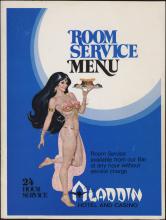Research Resources
There is a vast literature on the history of food and the development of cuisine through the ages; this exhibit utilized only a small number of these works in its brief narrative. Some of these included the wide-ranging Scribner Encyclopedia of Food and Culture (2003) Katz and Weaver, eds. ; Franck and Brownstone’s Restaurateurs and Innkeepers (1989); Gay and Gay’s Encyclopedia of North American Eating & Drinking (1996); Mennell’s All Manners of Food: Eating and Taste in England and France from the Middle Ages to the Present; and From Boarding House to Bistro: the American Restaurant Then and Now (1990) by Richard Pillsbury. Of particular note is Rebecc Sprang’s (2000) superbly-researched The Invention of the Restaurant: Paris and Modern Gastronomic Culture which provides the master narrative of restaurant history in Paris and chronicles the significant role that menus played in this development. Scanning the bibliographies of any of the above-mentioned works would provide an additional plethora of food history sources.

There are few stand-alone works on the history of menus and all are primarily visual in nature. These include Greenstein’s A La Carte: A Tour of Dining History (1992), Heimann’s May I Take Your Order: American Menu Design, 1920-1960 (1998) and Classic Menu Design: from the Collection of the New York Public Library (1988) by Reynaldo Alejandro. As noted in the exhibit text, there are a large number of works on menu design and marketing directed at culinary and hotel students. Although not used in this exhibit, most books on modern menu design can be found under the following subject headings:
Graphic design information for much of the nineteenth century menus was taken from the second edition of Meggs’ classic History of Graphic Design (1992). Heimann (1998) provides insightful information on mid-twentieth century menu design, covering the period from which many of the Las Vegas menus originate.
Information on dining in Las Vegas came from several sources, including a number of guide books dating from the late 1960s and early 1970s. George Stamos’ Las Vegas Sun series, “The Great Resorts of Las Vegas” from 1979 is still one of the best sources for the history of the most notable hotel-casinos on the Las Vegas Strip and provides valuable information on the restaurants within the hotels. Contemporary accounts such as Best and Hillyer’s Las Vegas, Playtown U.S.A. (1955), and Reid’s Las Vegas: City without Clocks (1961) provide fun anecdotes about dining in Las Vegas during the golden resort years. Gourmet’s Gamble (1962) is a unique history/cookbook about Las Vegas with recipes from the chefs of all the major Strip hotels in the early 1960s. Guidebooks such as Sonnett’s Guide to Las Vegas (1969), Guidebook to Las Vegas: Where to Go, Where to Stay, Where to Eat, Where to Have Fun and What to Do in Las Vegas (1972) and Silberstang’s Las Vegas: An Insider’s Guide and Gambling Hand Book (1975) all provide a glimpse of how Las Vegas dining was viewed in past decades.
